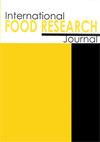约旦橄榄油中多环芳烃和有机氯农药的风险评估
IF 1
4区 农林科学
Q4 FOOD SCIENCE & TECHNOLOGY
引用次数: 0
摘要
许多有机氯农药(ocp)和多环芳烃(PAHs)对人类健康构成风险;因此,应不断监测食物中它们的含量。本研究对约旦橄榄油中21种OCPs残留和16种致癌多环芳烃的潜在健康风险进行了评价。从约旦的9个橄榄磨坊共采集了27个橄榄油样本。采用气相色谱-质谱联用法测定多环芳烃和OCPs的含量。在所研究的农药中,检测样品中仅检出4,4-二氯二苯二氯乙烯(4,4- dde)。然后评估4,4- dde的估计平均膳食摄入量(EADI)和危害风险指数(HRI)。4,4- dde的估计HRI值小于1,因此表明对消费者没有健康风险。橄榄油中16种多环芳烃的平均浓度为36.5µg/kg。通过测定膳食每日摄入量(DDI)和毒性当量商(TEQ)来估计多环芳烃污染对健康的危害。DDI和TEQ值分别为0.139 ~ 7.70 × 10-2和0.01 ~ 0.57µg/kg。样品中以轻PAHs为主,未检出重PAHs。对橄榄油的终生致癌风险增量(ILCR)进行估算,其值在0.1 × 10-7 ~ 5.62 × 10-7之间,所有橄榄油样品均未超过10-6的极限值,潜在风险不显著。本文章由计算机程序翻译,如有差异,请以英文原文为准。
Risk assessment of polycyclic aromatic hydrocarbons and organochlorine pesticides in olive oil in Jordan
Many organochlorine pesticides (OCPs) and polycyclic aromatic hydrocarbons (PAHs) pose risks to human health; so, their levels in foods should be constantly monitored. In the present work, the potential health risks of 21 OCPs residues and 16 carcinogenic PAHs in Jordanian olive oil were evaluated. A total of 27 olive oil samples were obtained from nine olive mills in Jordan. The levels of PAHs and OCPs were evaluated by gas chromatography coupled with mass spectrometry detector. Among the studied pesticides, only 4,4-Dichlorodiphenyldichloroethylen (4,4-DDE) was found in the tested samples. The estimated average dietary intake (EADI) and hazard risk index (HRI) were then assessed for the 4,4-DDE. The estimated HRI value of 4,4-DDE was less than 1, thus indicating no health risk to consumers. Regarding PAHs, the average concentration of 16 PAHs in the tested olive oil was 36.5 µg/kg. Health risks due to PAH contamination were estimated by determining the dietary daily intake (DDI) and toxic equivalent quotient (TEQ). The values ranged from 0.139 × 10-2 to 7.70 × 10-2 and 0.01 to 0.57 µg/kg for DDI and TEQ, respectively. Light PAHs were predominant in the samples, while no heavy PAHs were detected. The incremental lifetime cancer risk (ILCR) was estimated, and the values ranged from 0.1 × 10-7 to 5.62 × 10-7, and none of the olive oil samples exceeded the limit value of 10-6, thus indicating insignificant potential risk.
求助全文
通过发布文献求助,成功后即可免费获取论文全文。
去求助
来源期刊

international food research journal
Agricultural and Biological Sciences-Food Science
CiteScore
1.40
自引率
0.00%
发文量
75
期刊介绍:
The International Food Research Journal (IFRJ) publishes papers in English, six (6) issues a year with the coverage of:
Food Science and Technology
Nutrition and Dietetics
Agriculture, multidisciplinary
Chemistry, multidisciplinary
The scope of the Journal includes:
Food Science, Food Technology and Food Biotechnology
Product Development and Sensory Evaluation
Food Habits, Nutrition, and Health
Food Safety and Quality
Food Chemistry, Food Microbiology, Food Analysis and Testing
Food Engineering
Food Packaging
Food Waste Management
Food Entrepreneur
Food Regulatory
Post-Harvest Food Management
Food Supply Chain Management
Halal Food and Management
 求助内容:
求助内容: 应助结果提醒方式:
应助结果提醒方式:


